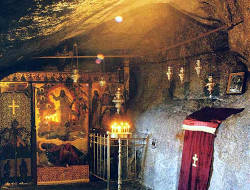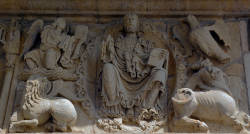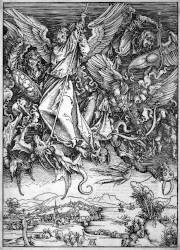Ιερό Σπήλαιο της Αποκάλυψης
Cave of the Apocalypse
Useful Information



| Location: |
Monastery of Saint-John the Theologian, Patmos Island.
(37.31449228127126, 26.544728268812165) |
| Open: |
All year Mon, Wed, Fri, Sun, Hol 8-13:30, Tue, Thu, Sat 8-13:30, 16-18. [2021] |
| Fee: |
Adults EUR 2. [2021] |
| Classification: |
 Karst Cave Karst Cave
|
| Light: |
 Electric Light Electric Light
|
| Dimension: | |
| Guided tours: | self guided |
| Photography: | allowed |
| Accessibility: | no |
| Bibliography: | |
| Address: | Cave of the Apocalypse, Cave of The Revelation, Patmos 855 00, Tel: +30-2247 031234. |
| As far as we know this information was accurate when it was published (see years in brackets), but may have changed since then. Please check rates and details directly with the companies in question if you need more recent info. |
|
History
| 95 | John exiled to Patmos by Emperor Domitian. |
| 96 | death of Emperor Domitian, John returns to Ephesos. |
| 1090 | church Agia Anna built. |
| 1999 | inscribed on the UNESCO World Heritage List. |
Description



The Ιερό Σπήλαιο της Αποκάλυψης (Holy Cave of Revelation) is also known as Cave of the Apocalypse, Holy Cave of the Apocalypse or Grotto of the Apocalypse. The Greek word apokalypsis translates revelation, so Cave of the Apocalypse is actually a mistranslation, still it is commonly used. The cave is located in the Monastery of Saint-John the Theologian on Pátmos Island in the Dodecanes. If you arrive with the ferry at the harbour at Skala just follow the road to the capital Chora, it is halfway. The monastery is a famous and popular pilgrimage destination.
The cave is not located in the monastery, actually it is the other way round. Originally there was a small natural cave, a shelter, on a rocky field in the middle of nowhere. John the Apostle was exiled to Pátmos by the Roman emperor Domitian in 95 CE and stayed there for two years. He lived in this cave under ascetic conditions and was haunted by disturbing revelations. He dictated what he dreamt to his disciple Prochorus, who later became Bishop of Nicomedia. What he dictated became the Book of Revelation, also called Apocalypse of John, and was the last book added to the Bible. It has been the focus of controversy ever since.
In the 10th century the Greek Orthodox monastery was built on top of the cave to protect it physically and to guard its spiritual importance. It has been an important place of Christian pilgrimage before and ever since. And like all those places it has those little feats, like the hollows in the rock where St. John has rested his head and hand. Nevertheless, this all is based on legend, there is no certainty that this is how it really happened, because Prochorus made no records of the future saint’s daily life. And the Middle Ages are known for Saints having dozens of elbows and Christ apparently being nailed on with a few hundred nails. The forgery of relics boomed and so did the declaration of holy sites. Pilgrimage was a prime business and remains so until today. In this case its not even clear who this John was and if he was actually John the Apostle. Probably they were two different persons, both named John.
The grotto is actually only a small overhang in thr rock face. It was a shelter for Saint John, but not very comfortable. The church was actually built in front along the cliff face, so the right side of the church is formed by the cave, the left side is building. As the shelter is quite low the right side is also much lower than the left. The church is a Greek orthodox church with a quite typical layout, not unlike all the other cave churches in Greece.
- See also
 Subterranean World Heritage List
Subterranean World Heritage List Search DuckDuckGo for "Cave of the Apocalypse"
Search DuckDuckGo for "Cave of the Apocalypse" Google Earth Placemark
Google Earth Placemark Cave of the Apocalypse - Wikipedia (visited: 16-APR-2021)
Cave of the Apocalypse - Wikipedia (visited: 16-APR-2021) John of Patmos - Wikipedia (visited: 20-APR-2021)
John of Patmos - Wikipedia (visited: 20-APR-2021) Monastery of Saint John the Theologian, official website (visited: 20-APR-2021)
Monastery of Saint John the Theologian, official website (visited: 20-APR-2021) The Historic Centre (Chorá) with the Monastery of Saint-John the Theologian and the Cave of the Apocalypse on the Island of Pátmos - UNESCO WHL (visited: 16-APR-2021)
The Historic Centre (Chorá) with the Monastery of Saint-John the Theologian and the Cave of the Apocalypse on the Island of Pátmos - UNESCO WHL (visited: 16-APR-2021) The Holy Cave of the Apocalypse (visited: 17-APR-2021)
The Holy Cave of the Apocalypse (visited: 17-APR-2021) Cave of The Apocalypse (patmos) (visited: 20-APR-2021)
Cave of The Apocalypse (patmos) (visited: 20-APR-2021)
 Index
Index Topics
Topics Hierarchical
Hierarchical Countries
Countries Maps
Maps